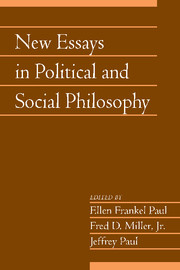Book contents
- Frontmatter
- Contents
- Introduction
- Acknowledgments
- Contributors
- Political Liberty: Who Needs It?
- State Coercion and Force
- Political Legitimacy and Economic Liberty
- Who Owns What? Some Reflections on the Foundation of Political Philosophy
- Human Reproductive Interests: Puzzles at the Periphery of the Property Paradigm
- Why Free Trade is Required by Justice
- Structural Exploitation
- Rescuing Justice from Equality
- Reinterpreting Rawls's The Law of Peoples
- Responsible Choices, Desert-Based Legal Institutions, and the Challenges of Contemporary Neuroscience
- Genocide and Crimes Against Humanity: Dispelling Some of the Conceptual Fog
- Harm and the Volenti Principle
- Education and the Modern State
- Index
Structural Exploitation
- Frontmatter
- Contents
- Introduction
- Acknowledgments
- Contributors
- Political Liberty: Who Needs It?
- State Coercion and Force
- Political Legitimacy and Economic Liberty
- Who Owns What? Some Reflections on the Foundation of Political Philosophy
- Human Reproductive Interests: Puzzles at the Periphery of the Property Paradigm
- Why Free Trade is Required by Justice
- Structural Exploitation
- Rescuing Justice from Equality
- Reinterpreting Rawls's The Law of Peoples
- Responsible Choices, Desert-Based Legal Institutions, and the Challenges of Contemporary Neuroscience
- Genocide and Crimes Against Humanity: Dispelling Some of the Conceptual Fog
- Harm and the Volenti Principle
- Education and the Modern State
- Index
Summary
Introduction
One of the most common criticisms made by activists and scholars opposed to sweatshop labor is that it is wrongfully exploitative. The economist's standard response to this charge is to point out that sweatshop labor provides tremendous benefits to workers—a fact demonstrated both by quantitative data on sweatshop wages and by the preferences of workers as revealed in their voluntary, indeed often eager, acceptance of sweatshop jobs. Such a response does not exactly defeat the charge of exploitation—an exchange can be mutually beneficial and nevertheless wrongfully exploitative. But it does seem to deflate the charge. Sweatshops, even if acting exploitatively, are at least doing something that provides substantial benefit to people in desperate need. By contrast, the vast majority of us—including companies that do not outsource their production overseas—do nothing to provide any comparable benefit. If this is exploitation, then how bad can exploitation be?
To some critics of sweatshops, however, this analysis appears to vindicate the moral status of sweatshop labor only by ignoring the very factors that make it morally abhorrent. It is a mistake, such critics contend, to focus so narrowly on the nature of the exchange between a particular sweatshop and a particular worker, and to note that the exchange is beneficial to the worker relative to the position in which she stood prior to the exchange.
- Type
- Chapter
- Information
- New Essays in Political and Social Philosophy , pp. 154 - 179Publisher: Cambridge University PressPrint publication year: 2013



